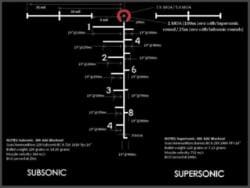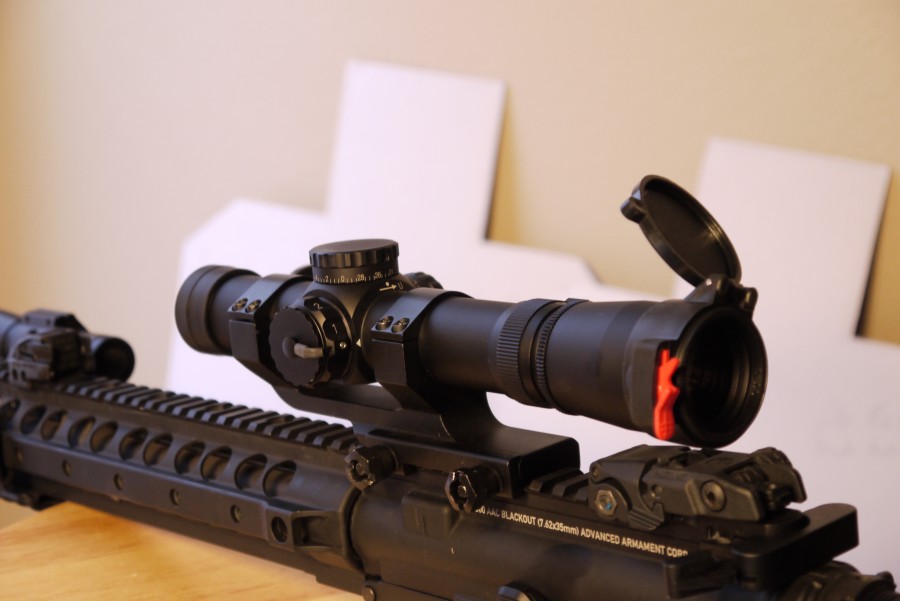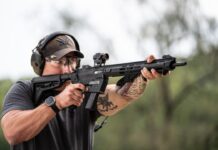There’s a story today about Browe’s (a relatively obscure optic maker) new reticle in their Combat Optic for the 300 AAC Blackout cartridge. The reticle itself is fairly awesome, being calibrated for both supersonic AND subsonic ammunition and all. But here’s the thing: I’m already testing an optic with this exact same reticle. And its made by Leupold.
A few weeks back Leupold approached me about testing out one of their new scopes with a specially designed 300 AAC Blackout reticle. Naturally, being a 300 BLK fanboy I was all over that as soon as she said the magic words: “would you like to try one?” And here’s what that reticle looks like:
See a slight similarity?
There are some extremely minor differences between the two reticles. The length of the substentions, for example, is slightly different between the two (with Browe’s being longer by an inch). And the Browe doesn’t have the tortoise and hare markings to tell you which is supersonic and which is subsonic, they spell that out. Other than that, its the exact same reticle.
Does Browe’s $1,400+ optic work as well as Leupold’s? And is it worth the price tag? We’ll let you know once we get our hands on one.







At first glance on the google machine, the price difference looks minuscule. I can’t wait for the review on the Leupold 300BLK scope. The tortoise and hare are a cute touch
The concept of the AAC .300 blackout reticle was benched marked off the Leupold reticle. The horseshoe and dot reticle is not unique and is being offered by many manufactures. Referencing stadia lines with for multiple calibers has also not unique and has been done for years. The reticles are similar, but different. He’s is a listing of the differences:
1. The 4×32 BCO AAC .300 Blackout reticle is based in meters vs. yards
2. The width of the reference stadia lines are 19” vs. 18”
3. The BCO top of the stadia tree comes to a point for an accurate 200m pin point shot placement and is illuminated vs. squared off and not illuminated
4. Our outer ring is 7moa vs. 7.5moa
5. Our horizontal reference is a MIL reference vs. referencing target speed
6. Our 1moa dot is zeroed at 100m supersonic and 25m Subsonic vs. 100m / 50m
7. The BCO is designed for different bullets, compare the 100m subsonic crosshairs
8. Stadia lines are .5 moa vs. unknown
9. Subsonic / Supersonic is spelled out vs. using images
We would be happy to provide an optic for T&E, once they’re in production.
Best regards,
BROWE, INC
Wow good on Browe for stepping up to the plate.
Not particularly surprising that it is very similar. If you are going to design a reticule for a particular round, I would presume that there is not that much variation that you can have between makes and models.
Here is my question – it seems like any really decent glass is going to run you north of $1,500. Is this really a price based on the cost to make something or are all of the companies marking up their costs significantly because they can? I’d love to get a Nightforce optic for my .300 Win Mag, but I’m looking at nearly $2K. Any ideas for something a bit cheaper that performs as well?
Most scopes above $1000 cost so much because they are selling you the cost of a warrantee associated with a brand name. You have to be vigilant when looking for a good scope. There is a lot of Chinese, Philipino, and Taiwanese stuff out there. People pay $1000 for something that could cost $400 and maintain the same quality. The $1000 to $1500 range seems to have either good quality, yet overpriced, scopes or scopes of excellent quality that could cost more. Think Nikon&Leupold&Bushnell&certain Zeiss models vs Nightforce&Trijicon. There is also another dividing line. Hunting, Sporting, Match, Bench Shooting vs. Combat and Tactical. The first group (NLBZ), as prices go from $300 to $6000, is on both ends of the price spectrum. All the tactical stuff is in the middle $600-$2000ish. The extreme stuff $7000 to $30000 is infrared EOTech craziness. Bottom line… To get a good +400 yard high power scope you will have to go with Nightforce, SWFA, Good Leupold, etc. If you are doing -400 yards you can go with Vortex, Primary Arms, Burris.
There are five types of lower price scopes in my opinion: 1. Paperweights. 2. Scopes that are durable and have optical quality with no features. 3. Scopes that have slight optical imperfections, features, and moderate durability. 4. Scopes that have everything you want except durability. 5. The perfect scope with lots of features at the perfect price but, never is because QC let’s too many clunkers out. I tend to go for scopes of type 3. Burris, Leatherwood, Primary Arms, SWFA, Vortex, Nikon, certain Leupolds, Bushnell etc make those kind of scopes.
Manufacturers such as Zeiss and S&B that offer high end merchandise are the cream of the crop because their scopes are truly repeatable. They don’t have chromatic aberration, warping, pin cushion, low MTF numbers, highly variable eye relief, wildly changing exit pupil sizes, inaccurate reticles, zeros that wander around when the power ring is turned, or POIs that curve when large wind or elevation adjustments are made. Since they actually engineer their scopes and use cutting eagle materials, they can offer a greater power range with a lighter and smaller scope.
Leupold’s Mark 4 with the 300 blk reticle costs ~$1300-$1400 so I don’t know why you point out Browe’s as being “$1400+” like it’s a big deal.
If I were a Swami I’d predict that the price will drop on the Leupold 300 blk in time. If I understand correctly it’s well over a $400 premium on for the 300 reticle compared to the standard reticles. I’ll have to settle for a nice Accupoint for now but that sure is nice.
Nick your 300 BLK is looking sweet !!!
People compare Browe scopes with Trijicon’s. I don’t know which one is better, but for me it looks like trijicon is proof reputable brand. I pre-ordered vcog last night vision tech eyes and now they give me discount for this browe scopes – http://techeyes.com/browe-4×32-bco-5-56mm-horseshoe-and-dot-reticle-arms-17-mount-bco-007-17.html
i’m wondering do i need to try it or it;s just waste of money???
Comments are closed.